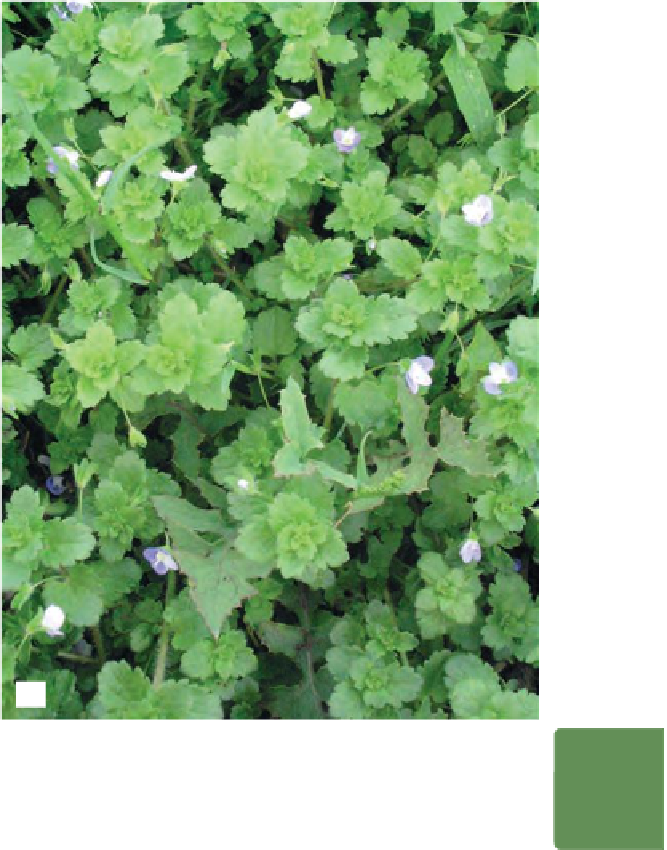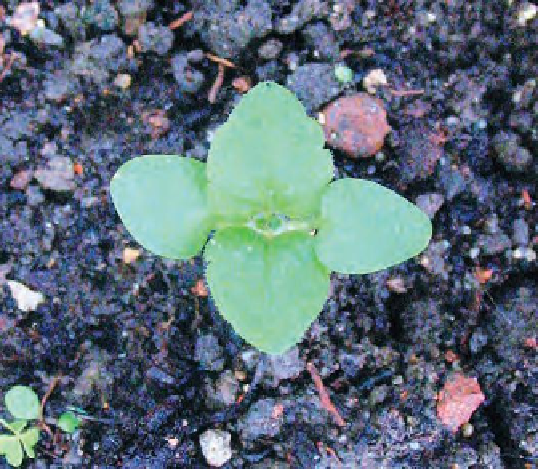Agriculture Reference
In-Depth Information
being recognized as a problem on fine turf (especially
on creeping bent,
Agrostis stolonifera
).
Spread
. This weed has no obvious dispersal
mechanism. Most seeds fall around the parent plant
and become incorporated into the soil, but heavy
winds may spread the seeds a few metres. Seeds
may be carried around on boots and wheels of
machinery. Worms may bring seeds to the soil surface
in worm casts.
Control
. This is achieved by a variety of methods. In
flower beds and vegetable plots, the
cultural
action
of hoeing normally controls the weed, especially when
it is in the young stage. Deep digging-in of seedlings
and young plants is also usually effective. Mulching
with material such as wood bark is effective against
germinating weeds in flower beds and fruit areas.
For turf, the general advice is to avoid patches of bare
turf, to avoid over-liming and to lift any weed flower
heads flattened by mowing so that the mower can be
more effective. Mowing in different directions helps
to achieve the same result. Not surprisingly, there
is
no herbicidal
control for a grass weed on a lawn,
or on sports surfaces. For control in bare ground,
ornamental beds containing woody perennials and
cane fruit, the amateur gardener can use the non-
selective, non-residual herbicide
glyphosate
,
but care
is needed to avoid spraying foliage of garden plants.
(a)
17
Speedwells: large field speedwell
(
Veronica persica
) and slender
speedwell (
V. filiformis
)
These belong to the plant family Scrophulariaceae.
Damage and location
. The first species, the large field
speedwell (
V. persica
), is an important annual weed
in vegetable plots, crowding out young crop plants
and reducing growth of more mature stages (Figure
17.14). The second species, a slender, mat-forming,
creeping perennial speedwell (
V. filiformis
), once
considered a desirable rock garden plant introduced
from Turkey, has become a common turf problem
(Figure 17.15) .
Life cycle
. The seedling cotyledons are oval, while
the true leaves are opposite, notched approximately
triangular and hairy (Figure 17.14) in both species.
The leaves of
V. filiformis
are about half the size of
V.
persica
.
Veronica persica
produces up to 300 bright blue
flowers, 1 cm wide, per plant. The flowers are self-
fertile and occur throughout the year, but mainly
between February and November. The adult plant
produces an average of 2,000 light-brown, boat-
shaped seeds (2 mm across). The seeds of this
(b)
Figure 17.14
(a) Large fi eld speedwell; (b) seedling
species germinate below soil level all year round,
but most commonly from March to May (see Figure
17.11), the winter period being necessary to break
dormancy. Seeds may remain viable for more than
two years.


